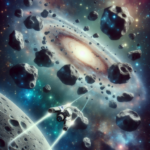Unveiling the Mystery: What’s Really Inside Our Moon?
The moon, Earth’s closest celestial neighbor, has fascinated humanity for millennia, inspiring countless myths, legends, and scientific inquiries. Despite being the subject of intense study, particularly since the dawn of the space age, the inner workings and composition of the moon have remained shrouded in mystery. Recent advancements in lunar exploration, however, are gradually peeling back the layers, offering unprecedented insights into what lies beneath its enigmatic surface.
At the core of this lunar exploration is the quest to understand the moon’s internal structure. Scientists have employed a variety of techniques to probe the moon’s innards, including seismic data from moonquakes, observations of its gravitational field, and analyses of lunar samples returned by missions such as Apollo. These studies have revealed that the moon possesses a differentiated structure, akin to Earth, comprising a crust, a mantle, and a core. The crust is primarily composed of oxygen, silicon, magnesium, iron, calcium, and aluminum, with notable variations in thickness. Beneath this lies the mantle, believed to be rich in magnesium and iron silicates. At the heart of the moon lies its core, which although smaller and less dense than Earth’s, is thought to be metallic, primarily consisting of iron and nickel.
One of the most intriguing aspects of lunar exploration has been the discovery of lunar water ice, hidden in permanently shadowed craters near the moon’s poles. This revelation has profound implications for our understanding of the moon’s geologic history and its potential as a stepping stone for deeper space exploration. Furthermore, the moon’s surface is covered in a layer of fine dust and rocky debris, known as regolith, which has offered invaluable clues about the moon’s past, including its formation and the impact history of the solar system.
Beyond its scientific intrigue, the moon’s internal composition has also captured the imagination of those looking towards future lunar missions and the possibility of lunar habitation. Understanding the resources available on the moon, from water ice that could support life to minerals that could be mined, is crucial for the planning of long-term human and robotic missions. As technology and exploration methodologies evolve, the mystery of what’s really inside our moon continues to be an unfolding story, promising to unlock secrets not just about the moon itself, but about the early solar system and Earth’s formation.
The Groundbreaking Discovery Inside the Moon Confirmed by Scientists
In an era where space exploration continually pushes the boundaries of what we know, a monumental discovery has emerged, shedding new light on our celestial neighbor, the Moon. This groundbreaking discovery confirmed by scientists has captivated the global scientific community and space enthusiasts alike. For years, the Moon’s interior remained a subject of speculation and intense study, with theories about its composition and the secrets it holds. However, recent advancements in technology and research methodologies have finally unlocked answers to long-standing questions.
Delving into the intricacies of this discovery reveals a complex inner structure that challenges previous understanding. Scientists, utilizing cutting-edge seismic data analyses and satellite imaging, have managed to gather concrete evidence on the Moon’s subsurface layers. This not only provides insights into the Moon’s geological past but also hints at the presence of materials and processes that were previously thought to be exclusive to Earth. The implications of these findings are vast, promising to revolutionize our approach to lunar exploration and the broader quest for understanding planetary formation and evolution.
The confirmation of such a significant discovery inside the Moon underscores the growing prowess of modern science in unraveling the mysteries of our solar system. It also opens new avenues for research, potentially leading to developments in space travel, resource utilization, and even the feasibility of lunar habitation. The continued investigation into the Moon’s interior is bound to yield more surprises, making it an exciting time for space exploration and scientific discovery.
Decoding the Lunar Secrets: What Scientists Have Found Inside the Moon
The Moon, Earth’s closest celestial neighbor, has captivated humanity’s imagination for centuries. Recent scientific expeditions and studies have started to unravel the mysteries lying within its desolate surface, revealing fascinating insights about its interior composition. These discoveries not only offer clues about the Moon’s past but also open new perspectives on the cosmos itself.
Analysis of lunar samples, returned by missions such as Apollo, has been instrumental in this exploration. Scientists have detected the presence of water ice in shadowed lunar craters, challenging previous assumptions about the dryness of the Moon. Furthermore, sophisticated seismic studies have allowed researchers to infer the Moon’s internal structure, including the size of its solid and partially molten core. This information is vital for understanding not only the Moon’s geological history but also its formation and the implications it holds for Earth.
Another groundbreaking discovery pertains to the Moon’s volcanic activity. By examining the composition of lunar rocks, scientists have concluded that the Moon was once geologically active. This activity suggests the existence of an internal heat source that might have powered ancient lunar volcanoes, shedding light on the thermal evolution of our natural satellite.
In addition, recent satellite missions have mapped the Moon’s gravitational field with unprecedented precision, providing insights into irregularities within its crust and mantle. These findings suggest variations in density and composition at different depths, which could point to the presence of significant resources, including rare minerals. Understanding these aspects not only satisfies our scientific curiosity but also has practical implications for future lunar exploration and potential resource utilization.
Array










